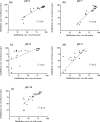The effect of pH on the acute toxicity of phenanthrene in a marine microalgae Chlorella salina
- PMID: 30514863
- PMCID: PMC6279824
- DOI: 10.1038/s41598-018-35686-9
The effect of pH on the acute toxicity of phenanthrene in a marine microalgae Chlorella salina
Abstract
Phenanthrene is one of the most abundant polycyclic aromatic hydrocarbons (PAHs) found in continental shelf environment of China and is on the EPA's Priority Pollutant list. In this study, the effects of phenanthrene on marine algal growth rate were determined after 96-h exposure at pH 6.0, 7.0, 8.0, 9.0, and 10.0 in seawater of salinity 35. Two measuring techniques to assess growth inhibition were also compared using prompt fluorescence and microscopic cell count. The results showed that the toxicity of phenanthrene increased significantly (p < 0.05) with decreasing pH, with the nominal concentration required to inhibit growth rate by 50%, EC50, decreasing from 1.893 to 0.237 mg L-1 as pH decreased from 9.0 to 6.0, with a decrease higher than 55% from 10.0 to 9.0. In addition, the nominal EC50 values calculated in this study were at the same range of some environmental concentrations of phenanthrene close to areas of crude oil exploration. Based on the two measuring techniques, the results showed that cell count and fluorescence measurement were significantly different (p < 0.05), and the nominal EC50 values calculated with cell count measurement were significantly higher than fluorescence measurement at pH 8.0, 9.0 and 10.0. In conclusion, the present studies confirmed that acidification of seawater could affect the toxicity of phenanthrene to this species of microalgae, and which encouraged further studies involving responses of marine organisms to ocean acidification.
Conflict of interest statement
The authors declare no competing interests.
Figures



References
-
- Keith LH. The source of US EPA’s sixteen PAH priority pollutants. Polycyclic Aromatic Compounds. 2015;35:147–160. doi: 10.1080/10406638.2014.892886. - DOI
-
- Law R, Dawes V, Woodhead R, Matthiessen P. Polycyclic aromatic hydrocarbons (PAH) in seawater around England and Wales. Marine pollution bulletin. 1997;34:306–322. doi: 10.1016/S0025-326X(96)00096-3. - DOI
-
- Wang, Z. et al. Characteristics of spilled oils, fuels, and petroleum products: 1. Composition and properties of selected oils. Tech. Rep., EPA/600/R-03/072 (2003).
Publication types
MeSH terms
Substances
LinkOut - more resources
Full Text Sources
Research Materials

